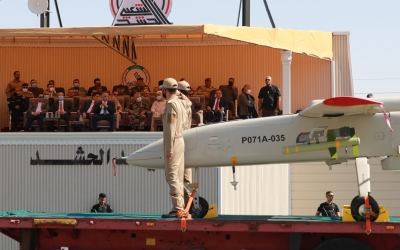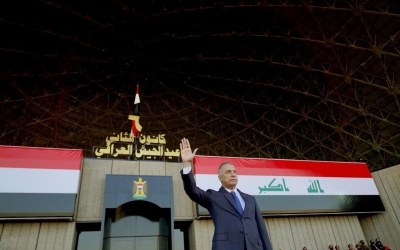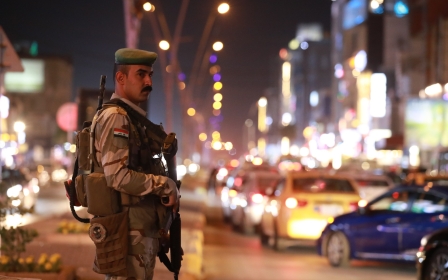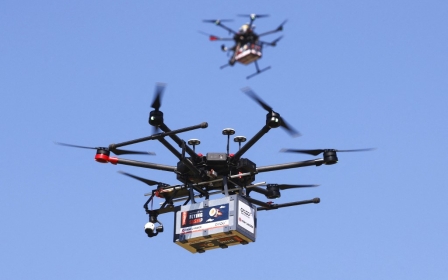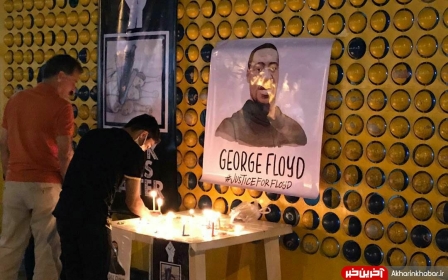Betrayed by Iran? Iraqi armed factions given 'slap' with Kadhimi drone attack

At the time, no one really noticed.
On 5 November, security forces and pro-armed faction protesters were playing a violent cat-and-mouse game outside Baghdad’s fortified Green Zone. Like various Iraqi leaders, Qais Khazali, leader of the ferocious Iran-backed paramilitary Asaib Ahl al-Haq, issued a statement urging calm. It was just one of many.
Yet his warning that parties linked to the intelligence services were plotting to bomb the Green Zone with the aim of "blaming the resistance factions", as the Iran-backed paramilitaries are known, took new significance two days later when a drone attack struck Prime Minister Mustafa al-Kadhimi’s house.
As accusations flew, with many blaming Asaib Ahl al-Haq and its fellow armed factions for the alleged assassination attempt, Khazali’s words began to be interpreted in two ways. Some believe he was giving himself cover for an attack he planned to launch.
New MEE newsletter: Jerusalem Dispatch
Sign up to get the latest insights and analysis on Israel-Palestine, alongside Turkey Unpacked and other MEE newsletters
Others, like Saad al-Saadi, a member of Asaib’s political bureau, insist that the faction and other paramilitaries have been framed. Saadi told Middle East Eye the plot was hatched by local and foreign powers, and was an attempt to take advantage of the chaos outside the Green Zone.
"The aim was to discredit the resistance factions and drag them into internal fighting," he said.
Saadi listed the usual roster of perpetrators that are commonly accused by Iran-backed factions: the United States, Israel and the UAE. Yet Khazali has notably been more circumspect.
The real plotters, sources told Middle East Eye, were Khazali’s patrons - the Iranians.
Avoiding escalation
Early November was a time of uproar and tensions in Iraq.
Iran-backed armed factions had performed appallingly in October’s parliamentary elections, and their supporters gathered outside the Green Zone demanding the results be cancelled.
Security forces swatted away demonstrators as they tried to storm the fortified neighbourhood, where the majority of government offices and diplomatic missions are based, but by 7pm calm had been restored. The armed factions’ supporters retreated to their protest camp nearby and all parties breathed a sigh of relief that there had been no fatalities.
The clashes were an "attempt to attract attention and prove their seriousness by putting pressure on the government", a military commander involved in securing the Green Zone told MEE. It seemed the point had been made.
An hour later, chaos engulfed the protest camp. The sounds of explosions and gunfire rang out, and flames started licking up protesters’ tents. CCTV footage shows men in police uniforms torching tents and a van belonging to a local TV channel.
A senior Asaib commander, Abd al-Latif Majid al-Khalidi, was killed during the clashes. Khalidi, who also fought within the Hashd al-Shaabi state-backed paramilitary umbrella group, was shot three times in the back, Asaib commanders told MEE. He died of his wounds in hospital.
Once again, Khazali, Kadhimi and other officials were in crisis-management mode. As rumours swirled, Khazali arrived at the protest camp and promised to "hold those who attacked the peaceful demonstrators accountable". He promised to bring Kadhimi and the perpetrators to trial.
Kadhimi and those around him deny any responsibility for Khalidi’s death. A military commander securing the Green Zone that day told MEE the prime minister issued strict orders to the security forces not to use live ammunition against the demonstrators for any reason. Attempting to diffuse the situation, Kadhimi sent a delegation including the interior minister and army chief of staff to Khazali.
"He was keen to explain his position to Khazali and to confirm that no orders to fire at the demonstrators came from him," a senior Hashd al-Shaabi commander told MEE.
According to the Hashd commander, Khazali promised Kadhimi he would not escalate the situation further, and wait for the results of an investigation into the killing launched by the prime minister.
'Everyone knows that Khazali respects his promises and that he is wiser than being directly involved in a reckless act'
- senior Hashd al-Shaabi commander
"Everyone knows that Khazali respects his promises and that he is wiser than being directly involved in a reckless act," he said.
At 2am on 7 November, Baghdad woke to more blasts and gunfire. Kadhimi, the authorities said, had been the victim of an assassination attempt.
The prime minister himself had been staying elsewhere and was unharmed. One of the three attack drones dispatched to the residence had managed to avoid being shot down, and caused a little damage as it exploded on the roof.
After all the commotion of the previous two days, fingers immediately began being pointed at Asaib Ahl al-Haq and Kataeb Hezbollah, as well as other Iran-backed factions. Khazali’s warning two days before started to be picked over.
"All the intelligence information available to us and our investigations confirm that the operation was carried out by one of the Iranian-backed armed factions," a senior military officer familiar with the investigations' progress told MEE.
"It is clear that Khazali was aware of the operation. But was he one of the decision-makers in implementing it or not? This is not clear so far."
'A warning'
It’s been three weeks since the attack, but authorities are yet to publicly disclose any more information about the investigation into the operation.
However, Middle East Eye received a technical report prepared by a military branch associated with the army chief of staff for “internal circulation”, which revealed that the attack was carried out with a short-range quadcopter drone. It’s a cheap model with limited range that has been repeatedly used by the Iranian-backed armed factions in Iraq since July 2020.
The quadcopter that hit Kadhimi’s home was carrying a missile weighing three kilograms, and was flying at a speed of 60-70 kilometers per hour.
The report calculates that the drone travelled a distance of 7km, and estimates it would not be able to travel this distance at this speed while carrying the missile "unless it was modified in a professional manner".
"This type of drone is primitive and cannot fly long distances with extra weight," a senior Hashd al-Shaabi commander told MEE.
"The hypothesis put forward is that the drone either took off from inside the Green Zone, or came from a very close area and flew along the fence, all the way to Kadhimi's house overlooking the river.
"Both possibilities exist until we obtain satellite images or Kadhimi's team shares with us what information they have."
The report concluded that the modified quadcopter was equipped with four electric motors with a capacity of 320 kilovolts. It used a Pixhawk with RFD868x control system, rudimentary PDB power distribution systems, and 18500 mAh battery packs. It could fly for a distance of 40km with a flight time of more than 120 minutes.
“Based on the information available so far about the incident, the strike was a warning, not a destructive one,” the report read.
“It is likely that the quadcopters used to attack Kadhimi’s house were operated by the same user who carried out previous attacks with the same type of drones [used] in Erbil and Baghdad [in March and July].”
A suspect is identified
Both US President Joe Biden and the European Union offered to help Iraq investigate the attack, but Kadhimi turned them down, sources in the prime minister’s office told MEE.
The Hashd al-Shaabi is attempting to conduct its own probe. But Hashd commanders told MEE they are being obstructed, with Kadhimi refusing to provide them with surveillance footage. One commander said the forensic team at the scene “had destroyed the most important evidence in the process, which is the missile”.
A senior officer in the Military Joint Operations Command told MEE that investigators were "very angry" and "surprised" by the detonation of the missile that was found on the roof of Kadhimi's house. They have no idea who gave the order to detonate it, the officer said.
'Kataeb Sayyid al-Shuhada is the key suspect in the attempt to assassinate Kadhimi. All the leaders know this, but they remain silent'
- Senior Iraqi official
A prominent Hashd al-Shaabi official close to Iran told MEE that the Hashd experts involved in the investigations excluded the United States from the list of suspects.
"The operation is not technically sophisticated. Whoever the perpetrator is, he is not experienced in this type of operation," he said.
The official investigation, which is led by National Security Advisor Qassem al-Araji, is shrouded in secrecy. But leaks do get out, some clearly indicating that the probe has concluded that Asaib Ahl al-Haq was not involved.
Instead, sources said, a small Iran-backed faction carried it out.
"Kataeb Sayyid al-Shuhada is the key suspect in the attempt to assassinate Kadhimi. All the leaders know this, but they remain silent," a senior official familiar with the investigations’ progress told MEE.
Kataeb Sayyid al-Shuhada, which was formed in 2014 to fight the Islamic State, is also the key suspect in the missile attack that targeted Erbil airport in March.
The Hashd official said there’s not yet enough evidence to confirm the faction is behind the Green Zone attack, but he’s not ruling it out.
"They are reckless and impulsive and are looking for a role to play."
The role of Iran
Officially, Iran has condemned the Green Zone attack, labelling it a threat to Iraq’s security. The day after, Tehran dispatched Esmail Qaani, head of the Revolutionary Guard’s elite Quds Force, to Baghdad.
Notably, Qaani shunned the leaders and the commanders traditionally close to Iran, meeting only Kadhimi and Hadi al-Amiri, the leader of the Badr Organisation, the oldest armed Shia faction backed by Tehran.
A Hashd leader close to Iran told MEE that Qaani conveyed a clear message to Kadhimi and the commanders of the armed factions: "Targeting the prime minister in this way is reprehensible and harms the higher interests of Shia, Iraq and internal security."
Although most of the public speeches of Iraqi leaders and officials have absolved Iran of involvement in the assassination attempt, behind-the-scenes conversations differ. The biggest question that is being asked in Iraq’s halls of power is: what was Iran’s actual role in the operation? It’s a question that no one has dared ask publicly.
In Kadhimi’s office, the sense is that Tehran’s hand is likely behind the attack, despite its supportive words subsequently.
"I can't be convinced that a small armed faction acted alone. The operation may not be technically complicated, but it needs great boldness and greater protection," said a senior official close to Kadhimi.
"It is true that these factions do not fear the Iraqi government, but they fear Iran and cannot disagree with it regarding major decisions,” he added.
"Everyone says that the strike was not fatal because the missile did not explode. But what if Kadhimi was at home at the time and the bomb exploded? What if the calculations were wrong and Kadhimi was killed in the attack?"
Here’s where Khazali comes in.
Sources in the Hashd al-Shaabi said Asaib Ahl al-Haq and Kataeb Hezbollah have been openly rebelling against Iran, outright defying Qaani’s orders.
Khazali and Abu Hussein al-Hamidawi, a Kataeb Hezbollah commander, have told the Iranians that Tehran’s support for Kadhimi getting a second term in office has broken the allies’ bond, a Hashd leader said.
"I believe that there is a party in Iran that gave the green light to this operation. They know that Kadhimi was not living in this house, but they wanted to implicate the factions," a senior Iraqi official close to the prime minister told MEE.
"A clean, quick operation with limited losses, but it speeds up the end of some armed factions, which have become a burden on Iran.
"It might just be a slap, so the faction leaders see for themselves what kind of problems Iran could create for them by using them."
This article is available in French on Middle East Eye French edition.
Middle East Eye delivers independent and unrivalled coverage and analysis of the Middle East, North Africa and beyond. To learn more about republishing this content and the associated fees, please fill out this form. More about MEE can be found here.



